The global DC electromagnetic brakes market is projected to grow from USD 2,564.7 million in 2025 to approximately USD 4,680.4 million by 2035, recording an absolute increase of USD 2,115.7 million over the forecast period. This translates into a total growth of 82.5%, with the market forecast to expand at a compound annual growth rate (CAGR) of 6.2% between 2025 and 2035. The overall market size is expected to grow by nearly 1.83X during the same period, supported by increasing industrial automation and growing demand for precision braking systems across various automotive and aerospace applications.
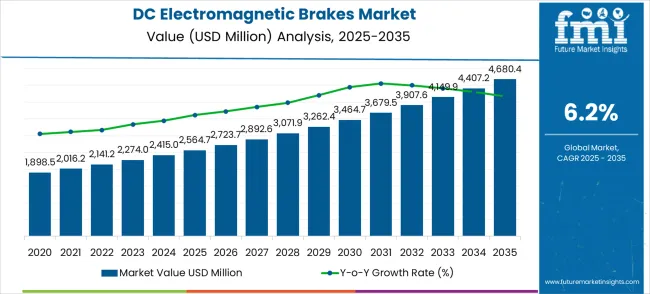
| Metric | Value |
|---|---|
| Market Value (2025) | USD 2,564.7 million |
| Market Forecast Value (2035) | USD 4,680.4 million |
| Forecast CAGR (2025–2035) | 6.2% |
Between 2025 and 2030, the DC electromagnetic brakes market is projected to expand from USD 2,564.7 million to USD 3,464.7 million, resulting in a value increase of USD 900.0 million, which represents 42.5% of the total forecast growth for the decade. This phase of growth will be shaped by rising automotive electrification across global markets, increasing demand for precision braking systems in aerospace applications, and growing adoption of advanced electromagnetic brake technologies in industrial machinery. Automotive manufacturers are investing in high-performance braking systems to improve vehicle safety and meet stringent regulatory requirements.
From 2030 to 2035, the market is forecast to grow from USD 3,464.7 million to USD 4,680.4 million, adding another USD 1,215.7 million, which constitutes 57.5% of the overall ten-year expansion. This period is expected to be characterized by expansion of electric vehicle production in developing countries, integration of smart braking technologies in aerospace systems, and development of specialized brake configurations for mining and construction equipment. The growing focus on safety and precision control will drive demand for advanced and reliable electromagnetic braking solutions across multiple industrial sectors.
Between 2020 and 2025, the DC electromagnetic brakes market experienced robust expansion, driven by increasing automotive production in emerging economies and growing awareness of advanced braking system importance. The market developed as automotive manufacturers recognized the need for reliable and precise braking systems to support safety-critical applications and meet evolving regulatory standards. Safety regulations and performance mandates began influencing procurement decisions toward advanced electromagnetic braking technologies.
Market expansion is being supported by the rapid automotive electrification across global economies and the corresponding need for reliable braking and safety control systems in automotive and aerospace applications. Modern automotive operations require precise braking control and safety management to ensure optimal vehicle performance and passenger safety. The superior reliability and performance characteristics of DC electromagnetic brakes make them essential components in demanding automotive environments where safety-critical operation is paramount.
The growing emphasis on vehicle safety and regulatory compliance is driving demand for advanced braking technologies from certified manufacturers with proven track records of reliability and performance. Automotive operators are increasingly investing in high-quality braking systems that offer improved safety performance and reduced maintenance requirements over extended service periods. Regulatory requirements and safety standards are establishing performance benchmarks that favor precision-engineered electromagnetic braking solutions with advanced control capabilities.
The market is segmented by product type, application, and region. By brake configuration, the market is divided into single-face electromagnetic brakes and double-face electromagnetic brakes. Based on application, the market is categorized into automotive industry, aerospace industry, mining and construction, and others. Regionally, the market is divided into North America, Europe, East Asia, South Asia & Pacific, Latin America, and Middle East & Africa.
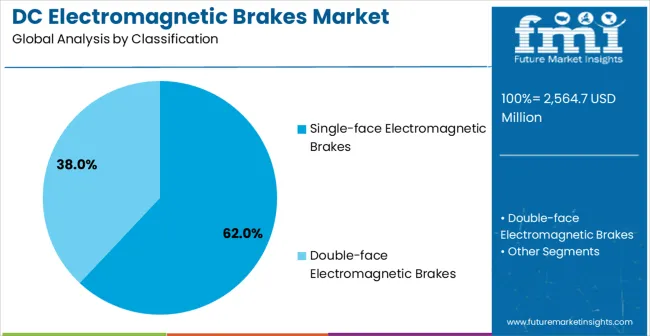
Single-face electromagnetic brakes are projected to account for 62% of the DC electromagnetic brakes market in 2025, reaffirming their position as the leading product category. Demand is driven by automotive and compact industrial applications requiring space-efficient, lightweight braking solutions. Single-face brakes optimize installation depth without compromising braking reliability, making them preferred for vehicles, aerospace components, and precision industrial systems. Advancements in magnetic circuit design, friction materials, and thermal management have improved torque density and operational durability while reducing maintenance complexity. Industrial machinery applications, such as servo motors and positioning systems, increasingly adopt single-face designs for performance-critical operations. The combination of compact form, high torque capacity, and reliability ensures this product type remains central to market growth and adoption across automotive, aerospace, and industrial segments.
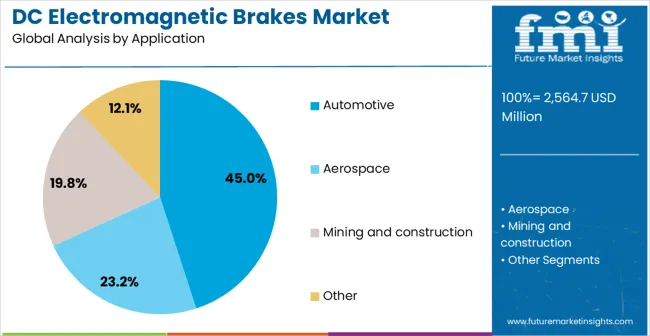
Automotive industry applications are expected to represent 45% of DC electromagnetic brakes demand in 2025, making them the largest end-use segment. The segment’s dominance is supported by vehicle safety requirements, high-performance braking needs, and increasing adoption of electric and autonomous vehicles. Automotive facilities require precise braking systems capable of operating under extreme temperatures, continuous cycles, and high-frequency use. Electrification trends, regulatory compliance, and safety standards further drive demand for reliable, compact electromagnetic brakes. The integration of smart braking features with sensors and electronic controls creates additional growth opportunities in modern automotive platforms. Emerging automotive markets in Asia-Pacific, Latin America, and other regions contribute significantly, as manufacturers invest in advanced braking technologies for vehicle performance optimization and safety enhancement.
The DC electromagnetic brakes market is advancing rapidly due to increasing automotive electrification and growing recognition of advanced braking system importance. However, the market faces challenges including high initial equipment costs, need for specialized maintenance expertise, and varying performance requirements across different automotive and industrial applications. Standardization efforts and certification programs continue to influence equipment quality and market development patterns.
The growing deployment of IoT-enabled control systems and digital monitoring interfaces is enabling real-time braking performance optimization and predictive maintenance capabilities in electromagnetic brake installations. Smart sensors and automated control systems provide continuous monitoring of braking parameters while optimizing performance and extending equipment service life. These technologies are particularly valuable for automotive and aerospace applications that require reliable braking performance and minimal system downtime.
Modern brake manufacturers are incorporating advanced magnetic materials and designs that improve braking performance while reducing energy consumption through optimized magnetic circuits and reduced power requirements. Integration of advanced friction materials and sophisticated thermal management systems enables precise braking control and significant performance improvements compared to traditional electromagnetic systems. Advanced materials and manufacturing techniques also support development of more compact and lightweight brake components for demanding automotive and aerospace environments.
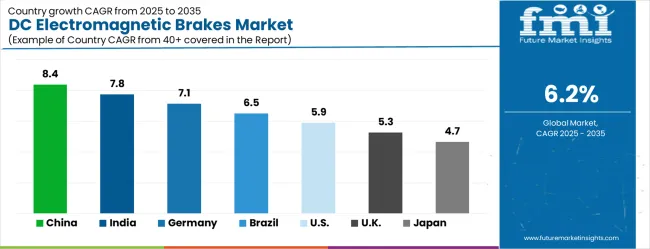
| Country | CAGR (2025–2035) |
|---|---|
| China | 8.4% |
| India | 7.8% |
| Germany | 7.1% |
| Brazil | 6.5% |
| United States | 5.9% |
| United Kingdom | 5.3% |
| Japan | 4.7% |
The DC electromagnetic brakes market is growing rapidly, with China leading at an 8.4% CAGR through 2035, driven by massive automotive production expansion, industrial automation, and manufacturing sector growth. India follows at 7.8%, supported by rising automotive manufacturing and increasing investments in industrial infrastructure development. Germany records strong growth at 7.1%, emphasizing precision engineering, quality standards, and advanced automotive manufacturing capabilities. Brazil grows steadily at 6.5%, integrating braking systems into expanding automotive and mining operations. The United States shows moderate growth at 5.9%, focusing on equipment upgrades and safety technology improvements. The United Kingdom maintains steady expansion at 5.3%, supported by automotive modernization programs. Japan demonstrates stable growth at 4.7%, emphasizing technological innovation and manufacturing excellence.
The report covers an in-depth analysis of 40+ countries top-performing countries are highlighted below.
The DC electromagnetic brakes market in China is projected to grow at a CAGR of 8.4% through 2035, supported by rapid automotive production and expansion of industrial automation programs. China is exceeding other regions in adoption of advanced braking technologies as electric vehicle manufacturing accelerates and automotive facilities integrate high-performance systems. Global and domestic suppliers are competing to provide efficient, reliable solutions tailored to large-scale production operations. China is also competing with Japan and Germany in automotive technology adoption and innovation, highlighting regional rivalry. Rising demand is supported by government-backed modernization programs and safety compliance mandates, positioning China as a key growth hub for precision braking systems.
The DC electromagnetic brakes market in India is forecasted to expand at a CAGR of 7.8% from 2025 to 2035, fueled by growth in automotive and aerospace manufacturing and infrastructure development. India is emerging as a major market for advanced braking systems, attracting global suppliers while domestic manufacturers compete with cost-efficient, specialized solutions. Automotive modernization programs and industrial automation initiatives are creating adoption opportunities across production facilities. India is competing with China in manufacturing scale and affordability for integrated braking technologies. Continuous investments in safety-compliant and high-performance systems are driving market penetration, enabling manufacturers to meet operational demands while supporting growing vehicle production and industrial modernization projects.
The DC electromagnetic brakes market in Germany is expected to grow at a CAGR of 7.1% through 2035, supported by precision engineering expertise and advanced automotive manufacturing practices. Germany is growing as a European leader in high-performance braking solutions that combine reliability, safety, and compliance with stringent quality standards. German manufacturers compete with international suppliers targeting automotive and industrial applications requiring precision control. Germany is also competing with France in premium automotive technology adoption, reinforcing market leadership through innovation and customization. Investments in automation and facility modernization continue to support adoption of advanced braking systems that optimize vehicle performance and operational safety.
The DC electromagnetic brakes market in Brazil is projected to grow at a CAGR of 6.5% through 2035, driven by expansion in automotive production and industrial operations, including mining and heavy machinery. Brazil is emerging as a significant Latin American market for reliable, high-performance braking systems. Domestic and global suppliers are competing to provide cost-effective and durable solutions for automotive and industrial applications. Brazil is competing with Mexico in attracting manufacturing investments and technological adoption for advanced braking systems. Residential and industrial modernization initiatives are enhancing demand, ensuring safety and performance standards in challenging operational conditions.
The DC electromagnetic brakes market in the United States is forecasted to grow at a CAGR of 5.9% through 2035, supported by automotive modernization, facility upgrades, and stringent safety regulations. The United States is advancing adoption through replacement demand and integration of high-performance braking systems in automotive and aerospace sectors. Domestic and multinational suppliers compete to provide reliable, low-maintenance solutions tailored to industrial and vehicle production requirements. The United States is competing with Germany and Japan in high-tech automotive braking applications, with rivalry driving innovation and performance differentiation. Regulatory mandates and safety programs continue to boost adoption, ensuring consistent growth across multiple vehicle manufacturing and industrial facilities.
The DC electromagnetic brakes market in the United Kingdom is projected to grow at a CAGR of 5.3% through 2035, supported by automotive modernization programs and industrial facility upgrades. The United Kingdom is expanding adoption of high-performance braking systems that ensure operational reliability, safety, and regulatory compliance across automotive and industrial sectors. Local manufacturers are competing with international suppliers to provide customized, performance-driven systems for production facilities. Competition between the United Kingdom and Germany is apparent in premium automotive and industrial applications, particularly in high-safety equipment. Facility modernization and automation initiatives are further strengthening adoption of advanced braking solutions.
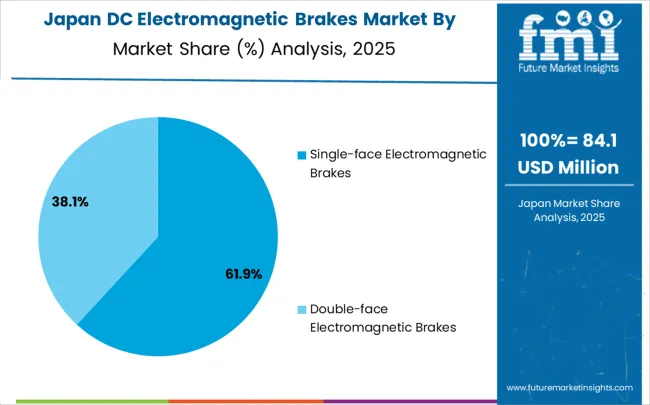
The DC electromagnetic brakes market in Japan is forecasted to grow at a CAGR of 4.7% through 2035, supported by technological innovation and advanced manufacturing practices. Japan is leading in precision-engineered, high-performance braking systems for automotive and industrial applications. Domestic manufacturers dominate the market, creating high barriers for new entrants. Japan is competing with China in automotive and electronics sectors, particularly in electric vehicle braking technology and industrial automation applications. Continuous innovation, safety compliance, and efficiency improvements are driving adoption, strengthening Japan’s reputation as a leader in advanced DC electromagnetic braking solutions.
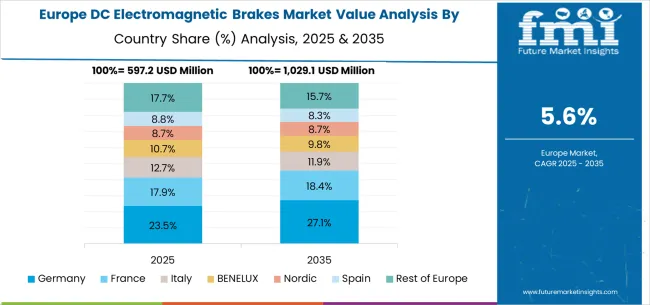
The DC electromagnetic brakes market in Europe is projected to grow from USD 597.2 million in 2025 to USD 1,029.1 million by 2035, registering a CAGR of 5.6% over the forecast period. Germany is expected to remain the largest national market with 23.5% share in 2025, rising to 27.1% by 2035, supported by its strong automotive base, advanced industrial infrastructure, and aerospace facility upgrades. The United Kingdom follows with 17.9% in 2025, inching up to 18.4% by 2035 as automotive modernization and aerospace investments expand. France accounts for 12.3% in 2025, easing to 11.9% by 2035, reflecting stable adoption across automotive and industrial applications.
Italy holds 10.7% in 2025, moderating to 9.8% by 2035, while Spain represents 8.7% in 2025, softening to 8.3% by 2035, supported by steady demand in automotive and aerospace sectors. BENELUX countries contribute 8.7% in 2025, moderating to 8.3% by 2035, while the Nordic region accounts for 8.8% in 2025, easing slightly to 8.7% by 2035, reflecting mature adoption in advanced industrial hubs. The rest of Europe (Eastern Europe and other emerging markets) collectively accounts for 17.7% in 2025, easing to 15.7% by 2035, supported by automotive development and aerospace manufacturing growth in emerging European economies.
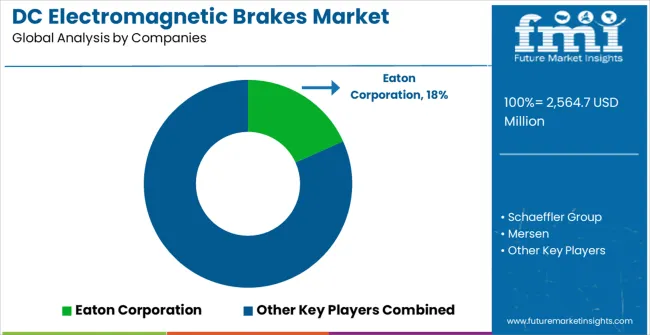
Competition in the DC electromagnetic brakes market is defined by established automotive component manufacturers, specialized braking system providers, and regional engineering firms. Eaton Corporation delivers integrated braking solutions emphasizing precision engineering, operational reliability, and global technical support. Schaeffler Group provides advanced systems with performance optimization and digital monitoring capabilities. Mersen focuses on industrial applications with high-performance, durable braking technologies.
Differentiation is achieved through material innovation, magnetic efficiency, and system customization. Brammer, part of IDEX Corporation, supplies industrial-grade solutions with tailored designs and specialized engineering support. Magnetek, a Columbus McKinnon company, emphasizes high-performance braking components suitable for demanding operational conditions. Wabco provides solutions engineered for rigorous automotive applications. Ogura Clutch Co., Ltd. integrates precision design with widespread manufacturing and service coverage. Baldor Electric Company, Nabtesco Corporation, Kendrion NV, and Zimmer Group contribute specialized expertise, regional production facilities, and customer-oriented technical assistance.
Product brochures highlight magnetic performance, control precision, maintenance simplicity, and safety compliance. Compact and modular designs are showcased to enhance adaptability across automotive and industrial platforms. Validated performance data and durability metrics are emphasized to reinforce operational reliability. Regional manufacturing capabilities, responsive service networks, and technical expertise are presented as core competitive advantages. Each brochure functions as a direct demonstration of product strengths, engineering sophistication, and market positioning, collectively reflecting the competitive dynamics and strategic differentiation shaping the DC electromagnetic brakes market.
The DC electromagnetic brakes market underpins automotive safety, aerospace precision, industrial automation, and sustainable transportation. With safety mandates, stricter performance requirements, and demand for precision braking control, the sector must balance cost competitiveness, safety reliability, and digital integration. Coordinated contributions from governments, industry bodies, OEMs/technology integrators, suppliers, and investors will accelerate the transition toward safety-smart, digitally monitored, and performance-oriented braking systems.
| Items | Values |
|---|---|
| Quantitative Units | USD 2,564.7 million |
| Classification Type | Single-face Electromagnetic Brakes, Double-face Electromagnetic Brakes |
| Application | Automotive Industry, Aerospace Industry, Mining and Construction, Others |
| Regions Covered | North America, Europe, East Asia, South Asia & Pacific, Latin America, Middle East & Africa |
| Country Covered | United States, Germany, India, China, United Kingdom, Japan, Brazil, and other 40+ countries |
| Key Companies Profiled | Eaton Corporation, Schaeffler Group, Mersen, Brammer (Part of IDEX Corporation), Magnetek (a part of Columbus McKinnon), Wabco, Ogura Clutch Co., Ltd., Baldor Electric Company, Nabtesco Corporation, Kendrion NV, Zimmer Group |
| Additional Attributes | Dollar sales by classification type and application, regional demand trends across North America, Europe, and Asia-Pacific, competitive landscape with established manufacturers and emerging suppliers, buyer preferences for single-face versus double-face braking systems, integration with digital monitoring and control technologies, innovations in magnetic materials and thermal management for enhanced performance and reliability, and adoption of smart braking solutions with embedded sensors and remote monitoring capabilities for improved operational safety and efficiency. |
The global DC electromagnetic brakes market is estimated to be valued at USD 2,564.7 million in 2025.
The market size for the DC electromagnetic brakes market is projected to reach USD 4,680.4 million by 2035.
The DC electromagnetic brakes market is expected to grow at a 6.2% CAGR between 2025 and 2035.
The key product types in DC electromagnetic brakes market are single-face electromagnetic brakes and double-face electromagnetic brakes.
In terms of application, automotive segment to command 45.0% share in the DC electromagnetic brakes market in 2025.






Our Research Products

The "Full Research Suite" delivers actionable market intel, deep dives on markets or technologies, so clients act faster, cut risk, and unlock growth.

The Leaderboard benchmarks and ranks top vendors, classifying them as Established Leaders, Leading Challengers, or Disruptors & Challengers.

Locates where complements amplify value and substitutes erode it, forecasting net impact by horizon

We deliver granular, decision-grade intel: market sizing, 5-year forecasts, pricing, adoption, usage, revenue, and operational KPIs—plus competitor tracking, regulation, and value chains—across 60 countries broadly.

Spot the shifts before they hit your P&L. We track inflection points, adoption curves, pricing moves, and ecosystem plays to show where demand is heading, why it is changing, and what to do next across high-growth markets and disruptive tech

Real-time reads of user behavior. We track shifting priorities, perceptions of today’s and next-gen services, and provider experience, then pace how fast tech moves from trial to adoption, blending buyer, consumer, and channel inputs with social signals (#WhySwitch, #UX).

Partner with our analyst team to build a custom report designed around your business priorities. From analysing market trends to assessing competitors or crafting bespoke datasets, we tailor insights to your needs.
Supplier Intelligence
Discovery & Profiling
Capacity & Footprint
Performance & Risk
Compliance & Governance
Commercial Readiness
Who Supplies Whom
Scorecards & Shortlists
Playbooks & Docs
Category Intelligence
Definition & Scope
Demand & Use Cases
Cost Drivers
Market Structure
Supply Chain Map
Trade & Policy
Operating Norms
Deliverables
Buyer Intelligence
Account Basics
Spend & Scope
Procurement Model
Vendor Requirements
Terms & Policies
Entry Strategy
Pain Points & Triggers
Outputs
Pricing Analysis
Benchmarks
Trends
Should-Cost
Indexation
Landed Cost
Commercial Terms
Deliverables
Brand Analysis
Positioning & Value Prop
Share & Presence
Customer Evidence
Go-to-Market
Digital & Reputation
Compliance & Trust
KPIs & Gaps
Outputs
Full Research Suite comprises of:
Market outlook & trends analysis
Interviews & case studies
Strategic recommendations
Vendor profiles & capabilities analysis
5-year forecasts
8 regions and 60+ country-level data splits
Market segment data splits
12 months of continuous data updates
DELIVERED AS:
PDF EXCEL ONLINE
DC Traction Switchgear Market Size and Share Forecast Outlook 2025 to 2035
DC and PKI Market Size and Share Forecast Outlook 2025 to 2035
DCIM Market Size and Share Forecast Outlook 2025 to 2035
DC Contactor Market Size and Share Forecast Outlook 2025 to 2035
DC Solar Cable Market Size and Share Forecast Outlook 2025 to 2035
DC Servo Motors and Drives Market Size and Share Forecast Outlook 2025 to 2035
DC BEV On-Board Charger Market Size and Share Forecast Outlook 2025 to 2035
DC Grid Connected Microgrid Market Size and Share Forecast Outlook 2025 to 2035
DC Motor Control Devices Market Size and Share Forecast Outlook 2025 to 2035
DC Powered Servers Market Size and Share Forecast Outlook 2025 to 2035
DC Switchgear Market - Size, Share, and Forecast 2025 to 2035
DC Power Supplies Market - Size, Share, and Forecast 2025 to 2035
DC Power Systems Market Trends - Growth, Demand & Forecast 2025 to 2035
DC Power Supply Module Market – Powering IoT & Electronics
DC Drive Market Size, Share, Trends & Forecast 2024-2034
DC-DC Converter Market Insights – Size, Demand & Forecast 2023-2033
ADC & DAC In Quantum Computing Market Size and Share Forecast Outlook 2025 to 2035
PDC Drill Bits Market Size and Share Forecast Outlook 2025 to 2035
HVDC Transmission System Market Size and Share Forecast Outlook 2025 to 2035
HVDC Converter Market Size and Share Forecast Outlook 2025 to 2035

Thank you!
You will receive an email from our Business Development Manager. Please be sure to check your SPAM/JUNK folder too.
Chat With
MaRIA